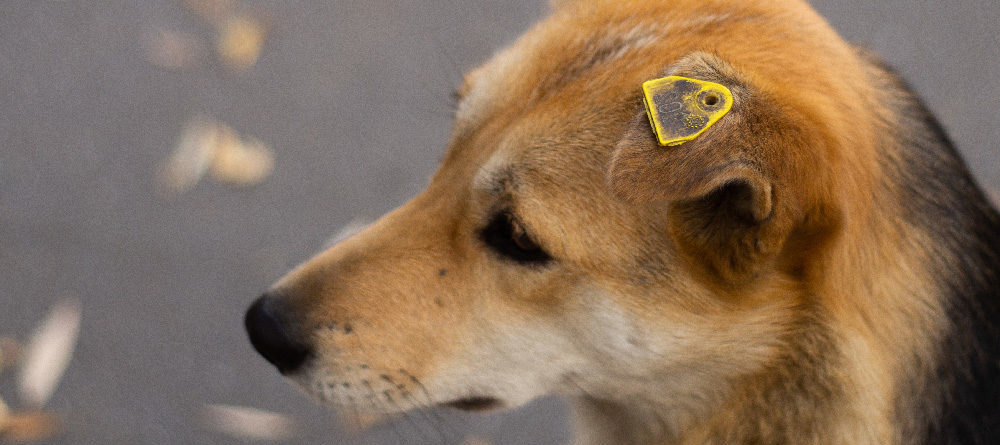
Project Summary
Please note: This is an archived project that is not currently being updated.
Marking dogs that have been sterilized or vaccinated is critical to ensuring that they are not inadvertently treated again. For stray animals, marking methods that are visible from a distance, do not require sedation, and are compatible with nonsurgical procedures are desired. Parsemus Foundation funded a study comparing ear tags to freeze branding methods of marking dogs, and this site also provides updated information on using tatoos. While we are no longer supporting work in this area, the information here should be helpful to individuals working with stray dog and cat populations.
Project Topics
Marking street dogs
Parsemus Foundation helped support research on ways to sterilize dogs and cats without surgery and anesthesia. But the current methods of marking which animals have been sterilized all require anesthesia. This creates a Catch-22!
In dogs, ear-notching (cutting a chunk out of the ear and then sealing the wound with heat cautery) is the most common way of identifying stray and feral animals that have been vaccinated and surgically sterilized. In cats, ear-tipping (cutting off the tip of the ear and then sealing the wound with heat cautery) is the standard method to mark surgically sterilized animals. (Tattooing inside the ear or the flank is also sometimes used, although like microchipping, this is not visible from a distance.)
But ear-notching and ear-tipping are not humane without anesthesia. So for street dogs or feral cats, how do trap-neuter-release programs show which ones have been nonsurgically sterilized without putting animals under anesthesia, which is part of what they were trying to avoid in the first place with nonsurgical sterilization methods?
Freeze branding vs. ear tagging
Parsemus Foundation funded a study comparing the welfare and logistical impacts of “ear-whiting” (also called freeze branding) with ear tagging. Ear whiting is currently used by some U.S. dog owners to mark their hunting dogs (as well as widely used on the flank on horses and cows). Ear-tagging is simply putting a tag on the ear, like is done for farm animals, which is currently in use in some trap-neuter-release programs in Eastern Europe and Turkey. The study compares how well they work and which is least stressful for the animal. Is either one humane enough to be done without anesthesia? That would spare animals anesthesia-related risks, for use with a nonsurgical sterilization procedure such as GonaCon Canine (multi-year injection for males and females) and calcium chloride injection (permanent for males)?

The study was conducted at a veterinary university in Italy in early 2013, with preliminary results presented at the 5th International Symposium on Non-Surgical Contraceptive Methods of Pet Population Control held in June, 2013 by the Alliance for Contraception in Cats and Dogs. The presentation of preliminary results at the ACC&D conference is viewable online. Results indicate that although ear-whiting was surprisingly well tolerated by the dogs, ear-tagging wins out for ease of use.
You can download our fact sheet and summary of the results to date, presented at the June 2013 conference, here: Street Dog Identification study fact sheet

Steinberger marking
A new method of marking dogs, cats or other mammals was devised in 2013 by Ruth Steinberger of the advocacy organization SpayFIRST!, while working at Oklahoma Spay Network, and is named in her honor. It quickly marks the ear or abdomen of an animal with very little discomfort.
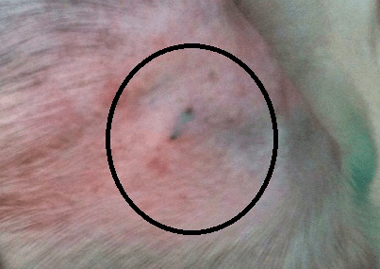
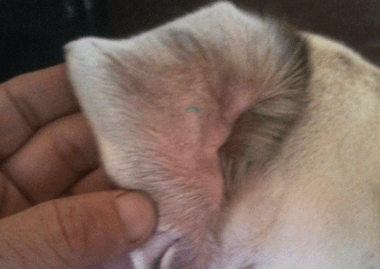
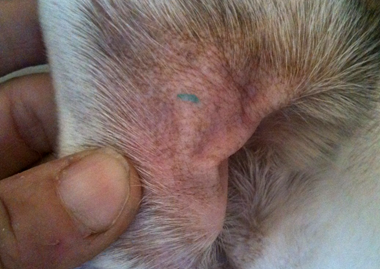
Photos above: Steinberger markings on ear of dog. Left: immediately after the procedure. Middle and right: six weeks after procedure. Photo credit: Ruth Steinberger
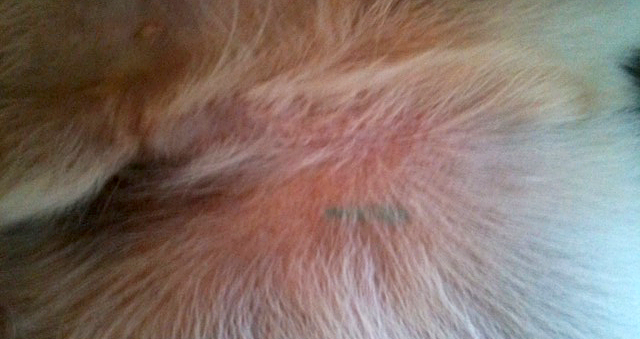
The procedure is straightforward: Choose the area of light-colored skin free of thick hair, generally the abdomen or inside of ear on a dog or cat. Put lidocaine paste or gel on the area and allow it to take effect. Use a 25 gauge or thinner needle in dogs. Use a 29- or 31- gauge need in cats to avoid tearing the delicate skin (an insulin needle should work, and is available behind the counter at pharmacies or purchased through a veterinary supplier). If using a separate needle and syringe, use a Luer lock syringe and needle hub to avoid messy spills. It is important to use human tattoo ink, not veterinary tattoo paste, for ease of flow; veterinary tattoo paste will go through a 25-gauge needle, but not thinner needles, and the human tattoo ink is also reported to be brighter. Draw tattoo ink (bright blue or green) into the syringe. Lay the syringe and needle parallel with the skin, and insert the needle just under the skin into the subcutaneous layer, 1 cm or more parallel with the skin. Inject the tattoo ink and withdraw the needle, leaving a line of tattoo ink under the skin. Below is a brief video of the procedure.
Courtesy of Ruth Steinberger, Spay FIRST!, September 2013
The mark is expected to be permanent—the ink does not appear to be absorbed by the body—and has been tracked so far for up to 2 years. The ink is at a lower layer of the skin than decorative tattoos. It forms a line several millimeters wide.
This method does have its limitations: 1) it cannot convey complex information (such as the number or barcode does on an ear tag), only a “yes/no” based on whether it is present or not and its location; and 2) except when used on erect ears such as in cats, it may not be visible from a distance.
However, the two anesthesia-free alternatives for marking free-roaming animals, freeze branding (“ear whiting”) and ear tagging, both have drawbacks as well. Freeze branding requires equipment and has a learning curve for getting reliable results, and ear tags can be susceptible to catching and infection. The Steinberger marking method therefore adds a valuable alternative.
For information comparing ear whiting/freeze branding and ear tagging in dogs: Leoci et al.: ACC&D conference, Fact sheet on identification methods
A new tattoo
The Alliance for Contraception in Cats and Dogs (ACC&D) has made marking and identification of free-roaming cats and dogs a flagship initiative. They have tested a cloth ear tag in dogs with mixed results and have moved toward a new concept: microneedle tattoos. It consists of a patch with tiny needles that can penetrate the skin without discomfort. This methodology is in development at Georgia Tech as a method to deliver the flu vaccine. ACC&D is working with the university to use the microneedle patch to deliver tattoo ink in the shape of numbers or letters, and thereby offer a method of tattooing animals without the need for anesthesia. As with other tattoo methods for use on animals, visibility from a distance is difficult, but this novel approach may provide a highly useful tool for identifying non-surgically contracepted dogs and cats.
- Last updated on February 1, 2024
Veterinarians Offering Alternative Methods of Contraception
Clients
Looking for a veterinarian willing to perform procedures beyond surgical spay or neuter? Browse our directory of qualified veterinary professionals.
Veterinarians
Do you offer alternative methods of contraception like ovary-sparing spay and vasectomy? Join our referral directory so new clients can find you.
Pet Health News

New guidance on reproductive control in cats and dogs
The World Small Animal Veterinary Association (WSAVA) has published a comprehensive guidance document on reproductive control in cats and dogs, and it’s a must-have for

Analysis of longevity in Rottweilers based on neuter status
A recent publication in Scientific Reports took an in-depth look at longevity in Rottweilers. The authors evaluated the health records of 7,185 Rottweiler dogs from

Understanding hemangiosarcoma in Golden Retrievers
A 2023 study on hemangiosarcoma in Golden Retrievers adds to our knowledge of this common canine cancer. As past studies have shown, the occurrence of hemangiosarcoma

New guidance on reproductive control in cats and dogs
The World Small Animal Veterinary Association (WSAVA) has published a comprehensive guidance document on reproductive control in cats and dogs, and it’s a must-have for

Analysis of longevity in Rottweilers based on neuter status
A recent publication in Scientific Reports took an in-depth look at longevity in Rottweilers. The authors evaluated the health records of 7,185 Rottweiler dogs from

Understanding hemangiosarcoma in Golden Retrievers
A 2023 study on hemangiosarcoma in Golden Retrievers adds to our knowledge of this common canine cancer. As past studies have shown, the occurrence of hemangiosarcoma

Parsemus’ work on hormone restoration in dogs featured
Parsemus Foundation Executive Director Linda Brent, Ph.D. was recently interviewed by veterinarian Peter Dobias, DVM about the foundation’s research on hormone restoration in dogs. Dr.


